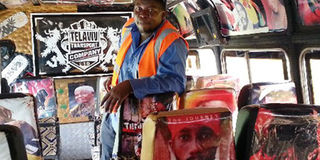Revenue gain as matatu graffiti returns

With the lifting of a 10-year ban on graffiti on matatus, graffiti business is looking up and promises more excitement on the road besides employment for youth. PHOTO | FILE
What you need to know:
- Highly influenced by pop culture, the coolest matatus in the city were painted and decorated with famous local and international artistes as well as famous slogans.
- As the competition for the hottest matatu grew, plasma screens were increasingly plastered inside matatus where one would even boast up to six screens. And for the purposes of outdoing each other, some went to the extent of placing them on the emergency exit doors for pedestrians to marvel at.
Early this month, President Uhuru Kenyatta made one of the most exciting announcements to many youths by allowing the return of graffiti in the matatu industry.
Banned by Transport Minister John Michuki in 2003, graffiti alongside loud music defined the matatu culture for many years, especially in the city.
Highly influenced by pop culture, the coolest matatus in the city were painted and decorated with famous local and international artistes as well as famous slogans.
As the ban began to take effect, some witty lines like “Hatujaeka picha” also found their way on emergency exits of matatus. They were jabs directed at the government for strangling graffiti artists talents’ and livelihood.
Prior to the infamous Michuki Law, public art or pimping and souping up (street names for decorating and customising with graffiti) of matatus took a whole new life as it was extended to huge plasma screens that played music videos, some explicit.
As the competition for the hottest matatu grew, plasma screens were increasingly plastered inside matatus where one would even boast up to six screens. And for the purposes of outdoing each other, some went to the extent of placing them on the emergency exit doors for pedestrians to marvel at.
But the government would soon tire of the theatrics. Michuki rules were fast introduced and enforced.
Seat belts and speed governors were installed, touts got a new dress code and graffiti was replaced by a yellow line and the route the matatu plies and, recently, the name of the Sacco it belongs to.
ROWDY BEHAVIOUR
After fighting a losing battle, matatu operators finally towed the line and graffiti business grudgingly came to a halt.
“The rules Michuki introduced affected us. Many of us lost careers and others ventured into entirely different businesses. After it was banned, we had to do it clandestinely and the clients would pay us peanuts because they thought they were doing us a favour.
But the President has finally recognised our talent and everyone else is finally taking notice,” says Michael Kinuthia a professional graffiti artist since 2007.
Graffiti in the matatu culture was and still is associated with rowdy behaviour; something that greatly influenced the ban. Banning graffiti and loud music was one way of achieving uniformity across all public service vehicles. Although uniformity was achieved, a source of livelihood was also yanked away from the budding artistes. Young and talented Kenyans take this form of art as an inspiration of culture and an avenue to express themselves. Since their main platform was no longer legal, they had to think out of the box in order to cash in on their talent from different avenues.
Now that graffiti and art work on PSVs have been given the green light, designers and graffiti artists are itching to further explore and work on ideas that they have been building up on. Although they are no longer limited creatively as they were before, the government will still implement rules to ensure that there is sanity on the roads in regards to graffiti. National Transport and Safety Authority (NTSA) chairman Lee Kinyanjui said the authority was formulating policy guidelines to implement the President’s directive without reversing the gains that have been achieved in bringing sanity to the matatu sector.
“As much as we might allow free expression, there must be rules to avoid instances where, in exercising this right of artwork on our PSVs, some might be tempted to have nudity and messages associated with extremism,” he said.
However, Michael counters that they are always eager to please the clients, hence they work on whatever the client wants drawn as long as they get paid.
PRETTY PENNY
Now that it is legal, designers and artistes’ phones are ringing off the hook and that means that the cost will go up. On a good day, customising a matatu, popularly known as “nganya” will set one back between Sh120,000 and Sh150,000.
And for Sh350,000, the vehicle can be customised to include classy car seats and a mean music system. Martin Wahome, a graffiti artist based in Buruburu says a well customised matatu will obviously attract more customers than a plain one.
“This is business that will cost you a pretty penny. It’s just like anyone would “soup up” a barber shop, salon or a boutique to attract clients. We have to constantly come up with unique ideas and get our names out there and people talking about our designs,” says Wahome.
Besides the money that come with it, the youth have once again found a loud and legal voice in which to express themselves.





